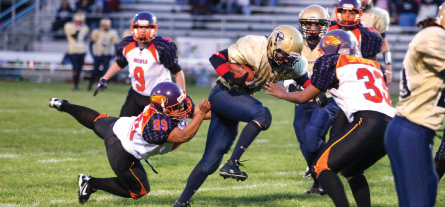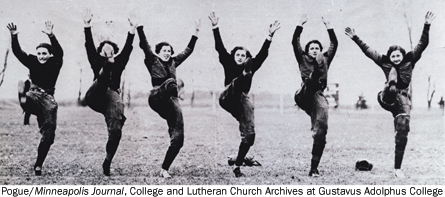Tackling women’s pro footballJennifer Carter’s research on women’s professional football is so hard-hitting that it left her bruised and nursing a torn hamstring. Carter, a graduate student in sociology at the University of Cincinnati, started observing the inner workings of a team in the Women’s Football Alliance from the sidelines during the 2011 season. Her goal: to figure out how women train for and protect themselves against the brutal physical contact of a sport associated, perhaps more than any other, with men.
With encouragement from the team’s players, Carter (shown below) suited up as a defensive back for the Cincinnati Sizzle. At the annual meeting of the American Sociological Association last August, she presented her initial results.


She found that players in the WFA — which has over 50 teams and more than 1,800 players — revel in bone-jarring hits as much as any multimillion-dollar masher in the National Football League. But women in pro football earn as little as $1 per game and cover their own expenses for uniforms, equipment, field rentals and travel. What’s more, football equipment isn’t designed for female bodies; women buy or borrow men’s helmets, shoulder pads and shoes. As concerns grow about concussions among male athletes wearing state-of-the-art gear, WFA players search for inexpensive, secondhand helmets.
“Players I knew sometimes got concussions and expressed concerns about head injuries, but no one changed their style of play as a result,” Carter says.
While female players avidly lift weights to get stronger, they tend to know little about football-specific weight training. Off-season conditioning occurred without coach or trainer supervision. And while WFA players play through most injuries, heeding tackle football’s tough-guy code, women have a harder time than men explaining their bruises, cuts and scrapes. It was easier for one Sizzle player to let her coworkers assume that she’d gotten badly bruised in an accidental fall, Carter says.
Carter plans to finish her research from the sidelines. She vividly remembers, though, the first hit she took in a game. While chasing a ball carrier on a kickoff, the excited rookie got flattened by an opponent she never saw. Out-of-the-blue, body-blasting pain like that is hard to describe, she says. But at least she can begin to describe how women transform themselves into football players.Girls on the gridiron

Women have been playing on the football field for almost 100 years. What began as a novelty act for 1920s halftime shows and the occasional women’s college team (above, a team from Gustavus Adolphus College in Saint Peter, Minn.) got a boost with the creation of a female U.S. semipro league in 1965. This Women’s Professional Football League started as a gimmick with teams in Cleveland and Akron but soon grew, adding cities as interest rose. Since then, women’s pro football has spread; leagues such as the WPFL have grown, merged and been transformed. Today, two main leagues — the Independent Women’s Football League and the Women’s Football Alliance — field dozens of teams, including the Palm Beach Punishers and the New York Knockout. — Sarah Zielinski







